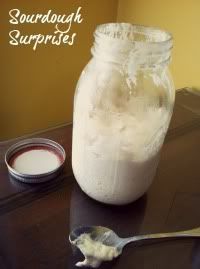
Last Sunday, I bottled my second batch of kombucha. Following a couple of suggestions on a website that Lo had suggested to me, I finished the bottles with about a tablespoon each of different fruit, including the blueberry, ginger and strawberry teas seen above. I filled the swing-top bottles as full as I could, and left them on the counter to continue their bottle fermentation. Early this morning, I cracked open a strawberry-blueberry bottle and actually had to hold the lid down due to the overwhelming carbonation. I was excited since my first bottling was tasty but fairly flat. I decided to put them all in the fridge, and got ready for my tutorial in homebrewing with R1's husband, Mr. Mork.

Boy-O and I drove out to the House of Mork around 9 this morning, and I couldn't wait to witness the whole process of homebrewing. Mr. Mork chose a kit from Northern Brewer called Tongue Splitter Ale, a west coast style ale with plenty of hops. He has been brewing at home for more than 10 years, so the process is second nature to him. His explanation to me of the brewing process was concise, and I couldn't help but think of the Northern Brewer employee who spent so much time talking with me last week. He was mentioning to a new homebrewer about the journey of brewing, not the end product - but the means to the end. That is exactly the process I got to see today, and it made me appreciate the craft of fermentation even more.
Mr. Mork purchased a kit to brew this beer, and explained that a kit allows a tried and true formula to be reproduced with a consistent result. A lot of trial and guesswork is removed when you go with a kit, and companies like Northern Brewer seem to have very detailed descriptions of the end result. Much the same way as a chef would publish a recipe for a home cook to follow, beer kits take a basic formula and let a homebrewer tweak the flavoring components. This can be done a little or a lot, and like pretty much anything food and flavor related, the possibilities are endless.
I was actually pretty surprised at how easy the entire process is. I mean, brewing a beer seems like something that you should leave the professionals, right? But like anything worth enjoying to the fullest, doing (or in my case, witnessing) the work yourself helps you appreciate the entire experience all the more.
The standard amount for homebrewing is 5 gallons, and that is exactly what I saw today. 2 gallons of pure, un-softened water went into the stainless brewing pot, and needed to come to a boil. Around 100 degrees, the grains went in, and the grain "tea" steeped until the water heated to the 170 degree mark.

After the grains come out, barley malt extract goes in. Mr. Mork lets the container sit in a sink full of warm water to help it pour easier:

After the extract goes in, the mixture returns to a boil, and you officially have a wort: the brewer's term for unfermented beer. After this point, the mixture boils for 60 minutes, with various variety of hops added at different times in the duration of the boiling. When I saw the sealed packets of hops, I was envisioning the actual hop blossom. I was surprised to open it and find this:

Chopped and pelletized hops! If you have ever smelled an ale, the characteristic hop bite that comes to your olfactories is nothing like the pure hop bite I smelled today. The fermentation process tempers the strong and almost metallic floral aromas. Each package had an alpha acid percentage, a different one on each of the 4 types used. The higher alpha content hops were added earlier in the boil. According to Homebrewing for Dummies, at harvest time, hops are measured for this acid content which is related to their bitterness. The alpha acid content percentage is a ratio of the acid's weight in relation to the weight of the whole flower, the higher the content, the higher the bitterness of the hop.
After our 60 minutes of boiling, I asked if I could taste the wort. It was thickened and syrupy, and surprisingly sweet from the addition of barley malt extract. It was delicious, and not at all as bitter as I thought it would be after smelling the hops as they boiled along.

After the wort was cooled using a wort chiller, the mixture was poured into a 5 gallon carboy to continue on it's journey to complete fermentation. The wort went in, followed by enough water to equal 5 gallons. Yeast is finally added, 100 billion yeast cells ready to work their magic on the humble wort. It now graduates into a growing and living thing, and active fermentation will begin in Mr. Mork's basement sometime within the next 24-48 hours. 7-14 days from now, second fermentation will begin, and 2-4 weeks after that, bottling will commence.
The whole process of brewing beer is strangely similar to the process of brewing kombucha, only instead of a SCOBY, the yeast is added as a liquid and no symbiotic union of bacteria is present (and, of course, more alcohol is produced as a result of the fermentation). Indeed, fermentation of most fermentable things is similar, and that is really amazing. I don't know why I thought there would be some complicated steps in the process, but really it is just an ancient technique, only modernized slightly by good hygiene practices and more intricate knowledge of flavor. I love to think about how imaginative people figured out how to brew, culture and ferment foods as a method of preservation. Mr. Mork relayed this story of the real King Midas, and a beer that was made based on the remains of the funeral feast found in his tomb. Here is the story of how a 2700 year old beer was recreated!
My copy of Wild Fermentation (recently recommended to me by E in Maine...) just came in from the library, and will be the perfect thing to read when I'm out of town for the next few days. I hope that I don't lose any of the memory of smells from today, since every one of the components of the Tongue Splitter were very distinct. I'm looking forward to trying the finished product and matching them to what I remember.
The whole idea of flavor profiling and taste memory is very fascinating to me. It is what makes a great cup of coffee, a stellar glass of wine, or even a cup of milk taste exactly like where it came from; it is what will help me find a good flavor for my kombucha experiments, and it is something that I am increasingly conscious of. Almost as if the more attention I pay to every component of the foods and drinks I consume, the more I appreciate them - an action of gratitude through consumption.

I have a flickr set of annotated brewing pictures, that you may peruse to see more of Mr. Mork's homebrewing process today, and I will update it as I continue to watch to progress of this batch. I'd like to encourage any curious and adventurous readers to get out there and try and brew something! Be it tea or beer or even a cup of joe, try really tasting what it is that makes you happy on a day to day basis and really appreciate the work that was involved to produce it. I promise you, you will taste it in a whole new light.
I have a bit of work to do in the kombucha fermentation field, since it seems that my natural carbonation dissipates through refrigeration. When I popped a few bottles to take some pictures this afternoon, all of the amazing fizziness that I was so excited about earlier this morning had vanished. Just a trace of that lid-popping effervescence remained, but it was enough to make me curious about what I'm doing wrong. Sunday evening, I'll likely bottle another batch, and tweak the process yet again, in the same manner of curious brewers from ages past. I could be frustrated, but I am not at all. Getting to the final destination is really half of the enjoyment!
I have a bit of work to do in the kombucha fermentation field, since it seems that my natural carbonation dissipates through refrigeration. When I popped a few bottles to take some pictures this afternoon, all of the amazing fizziness that I was so excited about earlier this morning had vanished. Just a trace of that lid-popping effervescence remained, but it was enough to make me curious about what I'm doing wrong. Sunday evening, I'll likely bottle another batch, and tweak the process yet again, in the same manner of curious brewers from ages past. I could be frustrated, but I am not at all. Getting to the final destination is really half of the enjoyment!
















Taste memory really is a brilliant thing -- and I find it's a bit more accurate than my "normal" memory :)
ReplyDeleteAs far as the carbonation issue goes -- refrigeration actually halts the processes that maintain the carbonation, so you'll have better results if you leave them at room temperature.
Oh, and a question for you -- has Mr. Mork ever made beer with "wet hops"? Or strictly the dried/pelletized hops? Have tried a number of wet hopped beers, and they have a deliciously floral flavor -- somewhat distinct from dry hopped beers.
ReplyDeleteGood luck with your experiment. I'm excited to see the result! I loved reading this post, too, because I'm pregnant and DYING for a good beer. Oh well. I suppose it will be all that much sweeter come December!
ReplyDeletewhen i took the beer making class I was also surprised at how easy the process was (and how good the taste of beer!) The hard thing for me is keeping the beer at a good temperature while the yeast works its magic... without either some high tech tools or an awful lot of buckets of ice it seems impossible in my hot third floor apartment... but just wait till fall I'm going to get going on fermenting again!
ReplyDelete